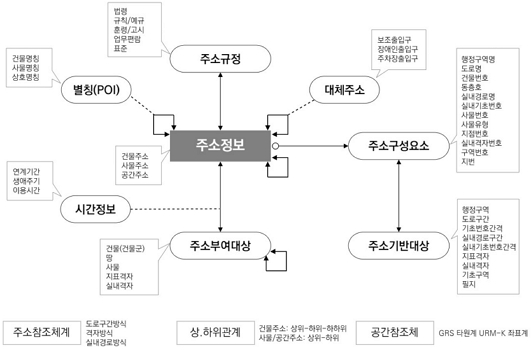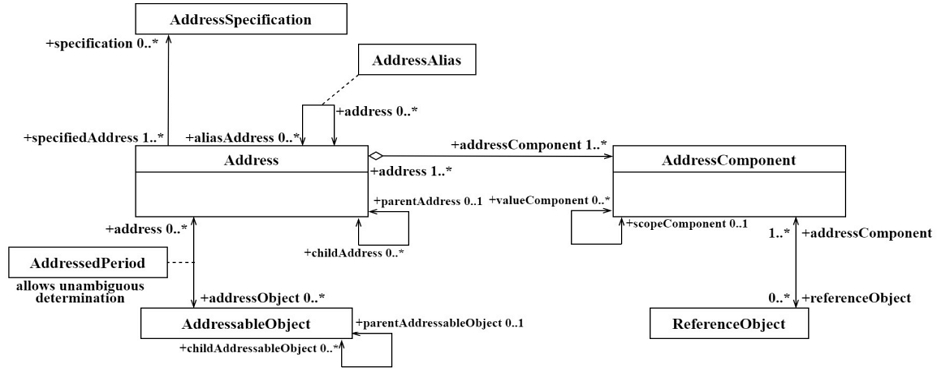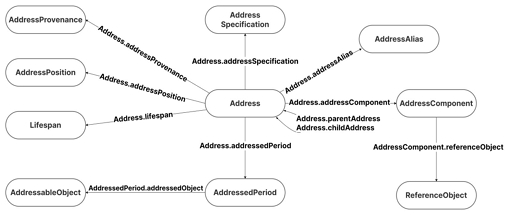
ISO 19160-1:2015 개념모델에 대한 분석과 이해
Copyright ⓒ 2024 The Digital Contents Society
This is an Open Access article distributed under the terms of the Creative Commons Attribution Non-CommercialLicense(http://creativecommons.org/licenses/by-nc/3.0/) which permits unrestricted non-commercial use, distribution, and reproduction in any medium, provided the original work is properly cited.

초록
주소는 사람, 기관 또는 기업의 위치를 식별하고 특정 개체의 관계를 나타내는 중요한 정보이며, 우편과 택배 등 물품을 전달하는 데 필수적으로 활용되고 있다. 일반적으로 주소는 행정구역, 건물 등 하나 이상의 구성요소를 조합하는 표기 규칙을 갖고 있으며, 주소의 표현 형식은 국가별로 동일하지 않다. 따라서, 주소의 국가 간 상호 운용 또는 주소의 표기 오류를 줄이기 위해 데이터 관점에서 주소 표준의 적용과 활용이 강조되고 있다. 본 연구는 국제표준인 ISO 19160-1:2015 개념모델의 특징을 소개하고, 국가별 추진 상황을 분석한다. 주소 데이터의 표준으로 제정된 ISO 19160-1:2015 개념모델의 특징을 먼저 살펴보고, 국가별로 추진된 표준 활동을 비교한다. 우리나라는 국제표준을 기반으로 독자적인 주소정보 개념모델의 개발, 사회 전반에 적용한 모범사례를 갖고 있다. 따라서 한국의 추진상황을 상세하게 살펴보고, 주소 모델 관점에서 향후 개선방안을 제안한다.
Abstract
An address is essential for identifying the locations of persons, institutions, or enterprises and is critical for delivering mail and goods. Addresses often follow formatting guidelines that include various components, including administrative regions and buildings, which might differ from one nation to another. Thus, interest has been concentrated on address standardization to enhance interoperability between countries and minimize address inaccuracies. This study investigates the attributes of the ISO 19160-1:2015 conceptual model, which is the global standard for address models, and evaluates the advancements achieved by different nations. We begin by outlining the characteristics of the ISO 19160-1:2015 conceptual model and analyze and contrast the standardization efforts of different countries. In particular, we introduce and describe the progress of Korea, which has developed a conceptual model of address information based on international standards and applied the address system in society. We also propose future improvement plans from the perspective of the address model.
Keywords:
Address, Address Model, Conceptual Model, Address System, ISO 19160-1키워드:
주소, 주소 모델, 개념모델, 주소체계Ⅰ. 서 론
일반적으로 주소는 특정 장소나 개체를 고유하게 식별하고 위치를 나타내는 정보로 도로, 건물번호, 행정구역, 우편번호 등 여러 정보를 조합하여 표시한다. 주소는 우편물, 택배와 같은 배달장소를 식별하는 전통적인 목적과 더불어 의료서비스, 긴급상황에서의 구조요청 등 일상 생활과 밀접한 분야로 활용 범위가 확대되고 있다. 한편, 국가 간 경제적 교류가 증가하면서 상품의 원활한 이동과 물류 네트워크의 효율성을 향상시키기 위해 주소의 역할은 지속적으로 강조되고 있다[1].
그러나 국가에 따라 주소의 구성요소와 표기 규칙이 동일하지 않기 때문에 국가 간 주소 데이터의 상호 교환이 쉽지 않다[2]. 국가 간 주소체계의 다양성은 주소형식의 불일치, 주소입력의 오류로 인한 우편물 분실과 배달 지연의 문제를 발생시킨다. 이러한 문제를 해결하기 위해 국제 표준의 제정, 주소의 표준화와 품질 향상, 국제적인 협력 강화와 같은 다양한 방안이 논의되고 있다. 특히, 국제 수준의 주소 표준은 국가 간의 주소 표현 형식과 표준화된 구성요소를 정의하여 정확하고 일관된 주소를 사용하는 기준으로 활용할 수 있다.
국제 우편 연합(UPU; Universal Postal Union)은 국제적인 우편 서비스의 표준화를 담당하는 주요 기구로서, 국가 간의 우편물 교환과 배송에 필요한 주소체계의 표준 정립에 노력하고 있다. S42 국제주소표준(International Addressing Standard)은 국제 우편 연합이 제정한 국제 주소 표준으로 주소 데이터의 구조, 요소, 형식, 표기법에 대한 일반적인 가이드라인을 제공하고, 우편물 교환과 배달 프로세스에서 발생하는 오류를 최소화하여 다양한 우편 시스템과 데이터 교환 시스템 간의 상호운용성을 제공한다[3]. 국제 표준화 기구(ISO; International Organization for Standardization)도 주소와 관련된 국제 표준을 제정하고 있다. ISO 19160에서 주소는 ‘식별과 위치 파악을 목적으로 대상을 명확하게 파악할 수 있는 구조화된 정보’로 정의하고[1], 주소 부여에 관련된 6개의 세부 표준을 규정하고 있다. 더불어, ISO 19111:2019(좌표 참조)[4], ISO 19112:2019(지리적 식별자 참조)[5]는 공간정보와 관련된 표준으로 주소 표준과 관련된 주제를 포함하고 있다. 대한민국 정부는 2010년부터 주소 표준화를 위해 국제표준의 제정과 적용에 적극적으로 대응하고 있다[6]. 2015년에 제정된 ISO 19160-1:2015 개념모델은 한국의 도로명 주소에 대한 예시가 포함되었고, 2023년에 표준으로 개정된 ISO 19160-2(주소 부여와 유지관리)는 한국의 주소체계에 적용된 공간에 대한 위치표시(건물, 사물, 공터), 입체 이동경로 안내(지상도로, 고가·지하도로, 내부도로), 접점의 위치 예측성을 우수사례로 포함하고 있다.
한국의 주소체계는 2014년에 지번주소에서 도로명주소로 전면 개편되었고, 이후 도로명주소, 사물주소, 공간주소 등 다양한 유형이 새롭게 개발되며 주소의 부여 범위를 건축물을 넘어 사물, 해안·해양으로 점차 확대하고 있다[7]. 한국의 주소는 도로명주소법을 법률적 근거로 국가주소정보시스템을 통해 관리되고, 주소정보누리집(도로명주소 안내시스템)과 주소기반산업지원서비스를 통해 공공·민간에서 주소를 활용하고 있다. 행정안전부는 제1차 주소정보 활용 기본계획(2022~2026)을 시행하며 주소를 ‘현실과 가상세계를 연결하는 매개체’로 정의하고 주소의 데이터 가치를 확대하고 있다. 데이터 관점에서 주소는 행정구역, 도로, 공간과 같은 다양한 구성요소의 결합된 특성을 갖고 동시에 서로 다른 도메인의 상세정보에 대한 참조기능을 갖는다. 이런 맥락에서 주소가 다양한 데이터와 연계 또는 통합되려면 데이터 표준에 대한 고려가 반드시 필요하다. 그러나, 한국 주소체계의 표준에 대한 논의는 위치, 공간정보 중심의 연구와 비교하여 미흡하기 때문에 이에 대해 체계적으로 논의할 필요가 있다.
본 논문은 ISO 19160 표준에 대해 전반적으로 살펴보고, 데이터 관점에서 주소를 기술하기 위한 ISO 19160-1:2015 개념모델을 분석한다. 이 표준은 주소를 구성하는 다양한 요소를 개념 수준에서 정의하고 있고, 서로 다른 주소체계를 상호운용하기 위한 공통모델을 지향하고 있다. 이와 같은 맥락에서 ISO 19160-1:2015 개념모델의 주요 특징을 살펴보고, 국가별 적용사례를 분석한다. 마지막으로 한국 주소체계의 개념모델로 개발된 주소정보 개념모델과 국제표준의 개념모델을 비교하고 향후 개선방안을 논의한다.
Ⅱ. 관련연구
주소는 사람들이 서로 통신하고 상품을 배송하기 위해 필요한 기본 수단이다. 그러나 국가별로 주소의 형식이 다르기 때문에 주소체계 사이의 일관성을 보장하는 것이 필요하다. 정확하고 일관된 주소체계를 유지하고, 주소 사이의 상호운용을 위한 연구는 지속적으로 진행되고 있다. Coetzee 등[2]은 국제 표준은 주소 데이터 품질의 향상, 주소 데이터의 공유와 더불어 표준이 존재하지 않는 국가에서 주소의 표준화를 위한 참조 모델의 역할로 중요하다고 주장한다. 이 연구는 덴마크, 호주와 뉴질랜드, 영국, 남아프리카 공화국, 미국 등 세계 각국의 주소체계를 분석하고, 주소 사이의 상호운용을 위해 국제 주소 표준의 필요성을 강조하고 있다. Cooper[8]는 국제 주소 표준을 위한 모델의 필수요소로 1) 주소 표준을 설명하거나 구축하기 위한 도구 집합, 2) 다른 모든 주소 표준의 상위 개념모델, 3) 다른 표준 사이의 범용적인 인터페이스를 제안하고 있다. 국제표준에 대한 논의는 2008년 5월에 ISO가 주최한 국제 주소 표준 워크숍[8]-[10]을 통해 구체화되었다. 특히, 워크숍을 통해 국제 주소 표준의 범위를 주소의 정의와 구성요소, 공통 용어와 어휘(온톨로지), 시스템 프레임워크로 구체화하여 ISO의 신규표준안건(NWIP; New Work Item Proposal)으로 등록하였다.
주소 표준에 대한 표준 활동과 학술 연구는 2005년~2012년에 집중된 경향이 있다[8]-[13]. 2015년에 ISO 표준으로 제정된 19160-1:2015 개념모델은 주소 표준에 대한 연구의 종합적 결과로 해석할 수 있다. 그러나, 개별 국가 차원에서 주소 모델을 적용 또는 확장한 사례는 많지 않고, 데이터 관점에서 19160-1:2015 개념모델을 해석하고 주소 데이터를 연계하기 위한 연구는 전 세계적으로 사례를 찾기 어렵다.
한국의 주소체계에 대한 국내 연구는 크게 세 가지 주제로 구분된다: 1) 도로명주소[14],[15], 상세주소[16], 사물주소[17],[18], 우편주소[19], 지하상가 주소[20] 등 주소의 부여방식과 기존 방식의 개선 연구, 2) 정규표현식 또는 지번과 지적 정보를 활용해 주소의 오류를 정제하기 위한 연구[21]-[24], 3) 주소와 공공데이터의 연계와 활용에 대한 연구[25]-[27]. 주소 표준에 대한 국내 연구는 일부 존재하지만[28]-[31], 한국 주소체계와 데이터 표준에 대한 체계적 연구는 미흡한 것이 현실이다. 행정안전부가 정의한 주소정보 개념모델은 ISO 19160-1:2015 개념모델을 확장하고 있다는 점을 고려하면, 국제 표준의 이해와 함께 현실적으로 적용할 수 있는 표준에 대한 연구가 필요하다.
본 논문은 ISO 19160-1:2015 개념모델, 웹 온톨로지로 구현된 ISO 주소 온톨로지의 주요 특징을 분석하고, 국가별 추진 현황을 살펴본다. 이를 바탕으로 행정안전부의 주소정보 개념모델과 국제표준을 비교하고 한국 주소체계를 위한 표준화 방안을 논의한다.
Ⅲ. ISO 19160에 대한 소개
ISO 19160은 ISO/TC 211에서 추진하는 국제 주소 표준으로 주소 사이의 상호운용을 촉진하고 다양한 유형의 주소 할당과 관리를 지원하는 목표를 갖고 있다. ISO 19160은 6개의 세부 과제를 포함하고 있으며, 2024년 4월 기준으로 4개의 세부 과제가 표준으로 제정되었고, 2개의 세부 과제는 취소되었다(표 1 참고).
1) ISO 19160-1:2015 Addressing - Part 1: Conceptual model
ISO 19160-1:2015는 국가별 주소 모델의 상호운용을 위해 추상적인 수준에서 주소의 핵심 요소를 규정하고 있고, 남아프리카 공화국의 주도로 2015년 12월에 제정되었다.
2) ISO 19160-2:2023 Addressing – Part 2: Assigning and Maintaining Address for Objects in the Physical World
ISO 19160-2:2023은 주소의 부여와 유지, 관리에 대한 표준으로, 남아프리카 공화국이 리더국으로 참여하여 2023년 11월에 제정되었다. 이 표준은 주소가 없는 국가가 참고할 수 있는 주소의 모범 사례를 제공하고 있다. 특히, 한국의 도로명주소와 사물주소(예: 비상급수시설)에 대한 우수사례를 포함하고 있다.
3) ISO 19160-3:2020 Addressing – Part 3: Address data quality
ISO 19160-3:2020은 지리 데이터 품질을 기술하는 ISO 19157:2013의 프로파일(profile)로 개발되어 주소 데이터의 품질에 특화된 프레임워크를 제공한다. 주소 데이터의 품질을 기술하기 위한 일련의 데이터 품질 요소와 측정값을 설정하고, 데이터 품질 보고 절차, 주소 데이터의 품질을 기술하기 위해 설정된 데이터 품질 요소와 측정값의 사용에 대한 지침을 제공한다.
4) ISO 19160-4:2023 Addressing – Part 4: International Postal Address Components and Template Language
ISO 19160-4:2023은 만국우편연합의 S42를 ISO 표준으로 제정한 것이다[30]. 이 표준은 3가지 계층(예: elements, constructs, segments)으로 우편주소의 구성요소를 정의하고, 구성요소를 우편주소의 정확한 형식으로 표현할 수 있는 템플릿을 제공한다. 이를 통해 국제적으로 우편주소 사이의 상호운용을 촉진하는 것이 목적이다. 19160-4는 만국우편연합의 주도로 2017년 11월에 제정되었고, 2023년 4월에 개정되었다.
5) ISO 19160-5 Addressing – Part 5: Address Rendering for Purposes other than Mail
ISO 19160-5는 한국이 리더국으로 진행한 표준으로 웹 지도와 휴대기기와 같은 다양한 매체에서 서로 다른 국가의 주소를 일관되게 표기하기 위한 지도규칙 표기 방법을 제공한다[31]. 그러나 표준 초안의 타당성 검토 단계에서 ISO 19117:2012로 주소의 지도표기가 가능하다는 의견이 수용되어 2018년 6월에 취소되었다[30].
6) ISO 19160-6 Addressing – Part 6: Digital Interchange Model
홍콩을 중심으로 진행된 표준으로, 19160-1의 개념모델을 UML에서 XML 형태로 변환하여 주소 데이터의 저장 및 교환을 위한 데이터 모델을 포함하였다. 그렇지만 데이터 모델을 통해 등록되어 관리되는 주소 데이터에 대한 특징과 상세 개념 정의가 19160-1의 개념모델에서 선언한 범위에 포함되지 않아 표준 추진이 2022년 2월에 취소되었다[30].
Ⅳ. ISO 19160-1:2015 개념모델
4-1 개념모델
개념모델(conceptual model)은 현실 세계의 복잡한 데이터 구조와 관계를 추상화하여 단순하게 표현하며, 이를 통해 정보 시스템에서 사용되는 데이터의 흐름과 상호 작용을 이해할 수 있다. 일반적으로 개념모델은 시스템에서 관리하는 중요한 데이터를 개체(entity)로 나타내고, 개체가 가지는 특성을 속성(attribute)으로 설명한다. 한편, 개체 사이의 연관성이나 상호 작용은 관계(relationship), 개체의 속성에 특정한 값의 범위를 나타내는 제약조건(constraint)을 포함한다.
ISO 19160-1:2015 개념모델은 주소 데이터에 표준으로 주소에 대한 개념, 용어, 주소 모델을 개념모델로 정의하고, 생애주기, 메타데이터, 주소 별칭이 함께 포함되어 있다. 예를 들어, 주소의 개념은 ‘식별과 위치 파악을 목적으로 대상을 명확하게 파악할 수 있는 구조화된 정보’로 설명하고, 주소를 부여하는 개체는 가상이 아닌 물리적 세계의 실외(예: 건물) 또는 실내(예: 건물 내부의 사무실)에 존재하는 것으로 제약하고 있다. 이런 맥락에서 웹에서 사용하는 이메일주소, 가상 주소는 해당하지 않는다. 주소 모델(address model)은 특정한 주소 데이터를 표현하고 관리하기 위한 모델이며, 주소체계를 표현하기 위해 요구되는 주소의 구성요소, 형식과 표기규칙을 구체화한 모델이다. 주소 모델에서 주소는 하나 이상의 주소구성요소의 집합으로 여러 개의 주소구성요소를 갖는 행(address line)으로 표시하고, 개별 행은 행정구역, 도로명, 우편번호를 포함할 수 있다
한편, ISO 19160-1:2015 개념모델은 주소의 공통 요소를 추상화하고 서로 다른 주소 모델 사이의 연계를 지향하고 있기 때문에, 실제 사용하고 있는 특정한 주소나 주소 모델을 대체하는 목적을 갖고 있지 않다. 이런 맥락에서 이 표준은 프로파일 개발 가이드라인을 함께 제공하여 특정한 주소체계에 맞게 확장할 수 있다. ISO 19160-1:2015 개념모델은 통합 모델링 언어(UML; Unified Modeling Language)로 주소 모델을 표현한다. 모든 클래스(또는 엔티티)는 속성을 포함하고 있고, 개별 속성은 필수 여부, 출현 횟수, 데이터 형식, 도메인에 대한 상세정보를 갖는다.
그림 1은 주소 모델을 구성하는 주요 클래스와 클래스 사이의 관계를 보여준다. AddressComponent 클래스는 행정구역, 도로명, 장소명, 우편번호 등 하나의 완전한 주소를 만드는 데 필요한 구성요소를 정의한다. ReferenceObject 클래스는 주소구성요소의 값이 참조하는 개체를 기술한다. ‘행정구역명’이라는 주소구성요소가 존재하면, 해당 장소에 대한 지리적 경계는 ‘행정구역명’의 ReferenceObject 클래스로 정의한다. 즉, 문자열로 표현된 값(예: “서울특별시”)이 갖고 있는 값을 정확히 참조하는 개체(예: “서울특별시”의 지리적 경계)를 나타내어 추가적인 정보를 연계할 수 있다. AddressableObject 클래스는 주소를 부여할 수 있는 대상으로 사업체, 건물, 필지와 같은 개체에 주소를 할당한다. 주소와 주소부여대상 사이에 주소가 부여된 기간을 나타내기 위해 AddressedPeriod 클래스를 사용할 수 있다. Addressed Period는 addressedFrom과 addressedTo 속성으로 각각 주소부여의 확인과 소멸된 날짜와 시간을 표현한다. 예를 들어, 건물이 재건축되어 주소는 동일하지만 주소부여대상이 변경된 경우, AddressedPeriod를 통해 주소부여대상과 기간을 관리할 수 있다. AddressSpecification 클래스는 주소를 부여하는 규칙, 주소의 참조 체계, 메타데이터와 관련된 구체적인 사양(specification)을 기술한다. 모든 주소는 Address 클래스로 표현하고, 주소 유형(address class), 위치(position), 생애주기(lifecycleStage), 출처(provenance)와 같은 속성으로 상세정보를 표시할 수 있다.
AddressAlias 클래스는 주소를 명확하게 식별하기 위한 대체 표현 또는 별칭을 표현한다. 이 클래스는 언어나 문화권에 따른 표기(localeAlias), 주소의 생애주기에 따라 변화된 주소 표기(lifecycleAlias), 주소의 비공식적 또는 구어체에 표기(colloquialAlias), AddressClass의 표기(classAlias)에 적용할 수 있다. AddressClass 클래스는 동일한 주소구성요소, 관계, 의미를 공유하는 주소 집합을 의미하고, 주소의 유형에 따라 확장될 수 있다. 예를 들어, 한국의 주소 클래스는 도로명주소와 지번주소로 구분할 수 있다. 별칭이 여러 개인 경우, 선호도(preferenceLevel)에 따라 우선순위를 나타낼 수 있다.
4-2 응용 프로파일
응용 프로파일(application profile)은 메타데이터 표준의 핵심 요소를 재사용하여 특정 도메인에 맞게 표준을 이용하는 것을 의미한다[32]. 표준은 정의된 규격을 변경 없이 사용할 수 있지만, 적용하는 환경에 따라 일부분을 수정하거나 제약조건을 변경할 수 있다. 응용 프로파일은 핵심이 되는 표준과 상호운용성을 보장하고, 필요에 따라 표준을 유연하게 조정할 수 있는 수단이다.
주소 모델은 주소에 대한 추상적인 수준의 개념요소를 기술할 수 있지만, 특정 도시나 국가에서 사용하는 주소 모델의 특수한 사례를 기술하려면 이에 필요한 응용 프로파일을 설계해야 한다. 응용 프로파일은 특정 도메인 또는 사용 사례에 맞게 표준을 수정하거나 확장하여 요구 사항을 충족시킬 수 있다. ISO 19160-1:2015 개념모델의 부속서 A는 프로파일 개발에 대한 지침을 상세하게 기술하고 있고, 부속서 C는 프로파일의 예제를 소개하고 있다. 그림 2는 최소한의 요구조건으로 프로파일을 적용한 한국 주소의 예시다. 주소 모델을 Address와 AddressComponent 클래스만으로 구성하고, 구성요소의 유형은 addressLine 속성의 값으로 문자열만 사용하여 주소를 표현한다.
응용 프로파일은 주소 모델을 기반으로 다양한 수준의 주소의 구성요소, 유형을 확장 또는 구체화하기 때문에 서로 다른 주소 모델 사이의 상호운용성을 높일 수 있다. 이러한 유연성은 표준의 활용성을 높이고, 주소체계의 일관성과 유효성을 유지하는 데 도움이 된다.
4-3 개념모델의 구현 - 웹 온톨로지 언어
ISO 19160-1:2015 개념모델은 통합 모델링 언어(UML)로 모델을 표현하고 있고, 동시에 웹 온톨로지 언어(OWL; Web Ontology Language)로 구현되어 있다. 일반적으로 UML은 소프트웨어 공학 분야에서 구조와 행위를 모델링하기 위한 목적으로 사용하고 의미 체계를 명시적으로 정의하지 않는다. 반면, OWL은 지식 표현과 추론을 위해 사용되고 명시적인 의미 체계를 갖고 있기 때문에 의미적으로 더 높은 표현력(expressivity)을 제공한다. ISO/TC 211의 온톨로지 관리 그룹(GOM; Group on Ontology Management)에서 제공하는 ISO 주소 온톨로지는 표준에 정의된 주소 모델을 OWL로 구현하여 기계가 읽을 수 있는 형식으로, 의미 체계를 표현하고 서로 다른 주소 모델의 의미적 상호운용을 지원하는 목표를 갖고 있다[33],[34]. ISO 주소 온톨로지는 주소 모델에 정의된 개념을 그래프 구조로 명시적으로 표현하고, 서로 다른 주소 모델 사이의 교차 매핑을 위한 공통 기준으로 활용될 수 있다.
그림 3은 주소 모델의 주요 클래스와 관계를 도식화하고 있다. ISO 주소 온톨로지에서 주소 모델의 클래스와 속성은 OWL, 코드리스트는 SKOS(Simple Knowledge Organization System)로 표현한다. 따라서, 모든 클래스(예: Address, AddressableObject, AddressComponent)는 owl:Class로 기술한다. 속성은 속성값의 유형에 따라 owl:Datatype Property 또는 owl:ObjectProperty 클래스의 유형으로 정의한다. 전자는 Address 클래스의 preferenceLevel 속성과 같이 문자열 또는 숫자 형식의 값을 표현하기 위한 속성이고, 후자는 AddressableObject 클래스의 type 속성과 같이 속성값의 특정한 클래스 또는 인스턴스를 표현할 수 있다. 주소 모델에 정의된 관계를 속성으로 표현하는 경우, 정의역(domain)과 공역(range)을 정의하고, 출현 횟수(cardinality)나 역관계(owl:inverseOf)와 같은 제약조건(owl:Restriction)을 구체적으로 기술한다. 예를 들어, Address 클래스와 Address Component 클래스는 addressComponent 속성으로 관계를 정의하여 주소를 구성하는 구성요소를 표현하고, Address Alias 클래스는 aliasAddress 속성으로 주소와 동일한 주소부여대상을 나타낼 수 있다. 이때, addressComponent와 alias Address 속성은 owl:ObjectProperty 속성의 유형이다.
한편, 주소 모델의 클래스와 속성은 ISO 주소 온톨로지에 그대로 표현되지 않는다. 예를 들어, ISO 19160-1:2015 개념모델에 있는 표 1(Address 클래스의 속성)에 따르면, Address 클래스는 addressedObject 속성을 갖고 있고, 이 속성의 유효한 값을 AddressableObject 클래스로 선언하고 있다[1]. 그러나, ISO 주소 온톨로지는 Address와AddressableObject 클래스 사이의 1:1 관계를 정의하지 않고, AddressedPeriod 클래스를 통해 두 클래스의 관계를 기술하고 있다. 즉, Address 클래스는 addressedPeriod 속성으로 Addressed Period 클래스의 관계를 기술하고, AddressedPeriod와 Addressable Object 클래스는 addressedObject 속성으로 연결된다. 한편, 속성의 표현은 일반적인 온톨로지 모델링 규칙을 적용하고 있지만, 어휘의 적용에 있어 주의가 필요하다. 일반적으로 온톨로지 어휘에서 속성명은 유일한 이름으로 정의하고, 정의역과 공역의 범위를 제한한다. 그러나 ISO 주소 온톨로지는 클래스명, ‘.’ 기호, 의미를 갖는 속성명을 조합하여 하나의 속성을 만든다. 예를 들어, ‘address’ 속성은 어떤 클래스를 Address 클래스로 연결하는 관계를 나타내는데, 두 개의 서로 다른 속성으로 정의되어 있다(예: AddressedPeriod.address와 Address Alias.address).
표 3은 UML과 OWL 모델에 정의된 클래스와 속성을 요약하고 있다. OWL 모델은 UML의 정의를 따르고 있지만, addressedObject 속성과 같이 의미가 변경되거나, 역관계를 표현하기 위한 속성이 추가되었다. ISO 주소 온톨로지는 UML에 비해 클래스와 속성의 관계를 엄격하게 선언하고 있다. 이런 방식은 서로 다른 주소 모델의 연계와 비교에 있어 효과적으로 사용할 수 있다. 그러나, 두 가지 표현 방식이 지향하는 목적이 다를 수 있고, 개념모델에 대한 해석이 동일하지 않다는 점은 실제 적용에 한계가 될 수 있다.
Ⅴ. 국가별 적용 현황
5-1 호주
호주는 뉴질랜드와 함께 ISO 19160-1의 주소 모델을 준용해 자국의 주소 모델을 개발하고 있다. 호주와 뉴질랜드 합동 표준 위원회의 지리정보/지리학 공동기술위원 IT-004(Joint Technical Committee IT-004, Geographical Information/Geomatics)의 주도로 호주와 뉴질랜드의 공동 표준이 제정되었다[35]. 한편, 호주 정부의 링크드 데이터 워킹 그룹(Australian Government Linked Data Working Group)은 ISO 주소 온톨로지와 거의 동일한 OWL 모델을 제공하고 있다. 호주 정부의 링크드 데이터 워킹 그룹은 온톨로지 명세에 접근할 수 있도록 HTML 버전의 명세를 제공하고 있고[36], 어휘에 대한 리다이렉트 서비스를 통해 역참조가 가능한 URI(Uniform Resource Identifier)로 변경하여 온톨로지를 관리하고 있다.
5-2 뉴질랜드
뉴질랜드는 4종의 뉴질랜드 국내 표준[37]-[40]을 활용하여 뉴질랜드의 주소체계에 맞는 프로파일[41]을 개발했다. 뉴질랜드의 주소 모델은 ISO 19160-1의 클래스와 속성을 대부분 상속하고, 뉴질랜드의 주소에 필요한 추가 클래스와 속성을 정의하고 있다. 예를 들어, AddressClass 클래스는 뉴질랜드의 주소체계에 있는 thoroughfare, water, service delivery, rural post delivery, thoroughfare 4819, water 4819를 포함한다. AddressClass 클래스는 주소의 유형에 따라 구성요소를 다르게 조합하고, 필수(mandatory), 선택(optional), 조건(conditional), 폐지예정(deprecated)으로 속성의 조건을 구분하고 있다. 예를 들어, thoroughfare 방식에서 도로명은 필수 구성요소이지만, water 방식에서 사용되지 않는다. 이 외에도 뉴질랜드의 주소 표준에 근거한 코드 목록을 개별적으로 정의한 사례(예: Access Point, Address Unit Type)와 같이 ISO 19160-1:2015 개념모델을 일부 수정하거나 구체화하고 하고 있다.
뉴질랜드의 주소 모델은 UML과 OWL 온톨로지를 함께 제공한다. 호주 정보 링크드 데이터 워킹 그룹과 함께 뉴질랜드는 OWL 모델을 개발하고, 뉴질랜드의 프로파일을 개발했다. 현재 뉴질랜드의 프로파일은 HTML 버전으로 온톨로지 명세를 확인할 수 있다[42]. 뉴질랜드의 프로파일은 호주의 OWL 모델을 준용하고 있지만, 4개의 클래스(AddressAlias, AddressComponent, AddressableObject, Addressed Period)는 새로운 클래스로 정의하고 추가적인 제약조건을 기술하고 있다.
5-3 미국
미국은 FGDC-STD-016-0211(United States Throughfare, Landmark, and Postal Address Data Standard)[43]과 ISO 19160-1의 상호운용을 위해 주소 모델에 대한 프로파일을 개발했다[44]. 미국 프로파일은 주소구성요소인 도로(Thorughfare), 랜드마크(Landmark), 우편번호(Postal) 등을 표현할 수 있도록 확장했다. 예를 들어, AddressComponent는 13가지(CompleteLandmarkName, CompleteAddressNumber, CompletePlaceName 등)로 세분화해 주소 유형별 구성요소를 구체적으로 정의할 수 있다. 한편, 미국의 프로파일은 FGDC-STD-016-2011의 요소를 매핑한 표를 제공하여 상호운용을 지원한다.
5-4 영국
영국은 ISO 19160-1:2015의 주소 모델과 거의 유사하지만, 일부 어휘를 수정한 프로파일[45]을 개발했다. 다른 국가의 프로파일과 유사하게, 영국에서 사용하는 주소의 유형을 정의하고(예: Street Address), 주소 클래스에 맞는 구성요소의 유형을 정의한다. 한편, 영국의 프로파일은 주소와 관련된 영국의 주요 표준 BS 7666-2[46]와 상호운용하기 위한 관계를 구체적으로 정의하고 있다. BS 7666-2는 토지와 부동산 공보에 대한 논리적 데이터 구조를 정의한 영국의 주소 표준이다. 영국의 주소 프로파일은 클래스와 속성 수준에서 BS 7666-2와 매핑 관계를 구체적으로 정의하고 있다. 예를 들어, BS 7666-2의 AddressableObject 속성인 UPRN (Unique Property Reference Number)은 영국의 주소 프로파일의 AddressableObject.id와 매핑된다. 영국은 OWL 형식으로 프로파일을 제공하지 않는다.
5-5 남아프리카 공화국
남아프리카 공화국은 ISO 19160-1의 초안 단계(ISO/DIS 19160-1)부터 적극적으로 참여하며, 남아프리카 공화국의 프로파일 문서를 함께 작성했다. ISO 19160-1이 제정된 후, 프로파일이자 남아프리카 공화국의 주소 표준으로 SANS 1883-2를 제정했다[47]. SANS 1883-2는 남아프리카 주소 데이터 표준인 SANS 1883-1[48]과 ISO 19160-1을 기반으로 개발되었다. 기존 SANS 1883-1의 주소 표준 모델의 클래스와 속성을 ISO 19160-1 개념모델에 맞게 확장해 표현하고 있다. 예를 들어, SANS 1883-1에서 정의한 남아프리카 공화국의 12개의 주소 클래스를 프로파일에서 Address 클래스를 상속받아 추가했다. 주소구성요소는 SANS 1883-1의 17개의 클래스를 프로파일에서 Address Component 클래스를 상속받아 추가하여 남아프리카 공화국의 주소체계를 세부적으로 표현한다.
Ⅵ. 한국의 주소 표준
6-1 추진현황
행정안전부는 한국의 주소체계를 국제표준에 반영하기 위해 노력하였고 매년 주소 국제표준화에 대한 보고서를 발간하고 있다[6]. 행정안전부는 2011년부터 ISO 19160 프로젝트에 참여하여 한국 주소체계의 우수성을 국제표준에 반영하는 데 노력하고 있다. 이러한 노력의 결과, ISO 19160-1:2015 개념모델에 한국 주소의 예시가 포함되었고, ISO 19160-2는 한국의 건물이 없는 도로변이나 산악에 위치 표시, 지하고가도로, 실내 이동경로를 지상도로와 구분해 별도의 도로명을 부여하는 방식을 우수사례로 소개하고 있다.
주소 표준에 대한 일련의 노력은 한국형 주소체계를 만드는 데 중요한 역할을 하고 있다. 2018년 12월에 한국은 ISO 19160-1:2015 개념모델을 번역하여 한국산업표준 KS X ISO 19160-1:2015[49]를 제정했고, 2019년과 2020년에 수행된 ‘주소의 국제표준화 대응방안 연구’를 통해 각각 ISO 19160-1의 프로파일링을 진행하여 KS표준(안)을 제안[50]하고, KS X ISO 19160-1 분석과 프로파일링을 기반으로 국내 주소 개념모델 표준(안)을 개발했다[51]. 국내 주소 개념모델 표준(안)은 한국의 주소 유형과 속성을 반영할 수 있도록 AddressClass와 AddressComponent 클래스에 적용하는 코드를 추가함으로써 코드리스트가 확장되었다. 2021년, 2022년의 주소 표준화 연구는 국내 주소 데이터 교환에 필요한 메타데이터 정보 제공과 데이터 품질 확보를 위해 주소 데이터 사양 표준(안)을 제안하고 있다[52],[53].
6-2 주소정보 개념모델
행정안전부는 ISO 19160-1 개념모델을 확장하여 주소정보 개념모델을 정의하고 있다. 주소정보 개념모델은 ‘주소정보 규정’을 근거로 ‘주소정보 부여대상’에 대한 ‘주소정보 구성요소’를 이용하여 ‘주소정보’를 관리하기 위한 개념모델이다[54]. 주소정보 개념모델의 핵심 개념과 관계는 ISO 19160-1:2015 개념모델과 매우 유사하고, 모델의 구조에 큰 차이가 없다. 주소정보 개념모델의 핵심 개념은 주소정보, 주소규정, 주소부여대상, 주소구성요소, 주소기반대상, 대체주소, 별칭, 시간정보로 구성되어 있다. 그림 4에서 보듯이, 주소정보 개념모델에서 주소정보는 주소규정, 주소부여대상, 주소구성요소와 1:1 관계로 정의된다. 반면, 주소참조체계, 상.하위관계, 공간참조체는 주소정보의 생성과 관리에 일정한 관계가 있지만, 개별 엔티티와 직접적인 관계를 명시적으로 표현하고 있지 않다.

Concept model of address information(Modified from [55])*This figure explains the address system of Korea, and it is described in the original Korean language as translating it into English would make it difficult to convey the intended meaning.
주소정보 개념모델은 ISO 19160-1:2015 개념모델을 기반으로 한국의 주소체계를 상세화하고 있다. 예를 들어, 주소정보는 건물주소, 사물주소, 공간주소로 세부 유형을 구분하고, 주소부여대상은 건물(건물군), 땅, 사물, 지표격자, 실내격자 등 주소가 실제 부여되는 대상을 구체적으로 정의하고 있다. 특히, 주소정보 개념모델은 주소정보기본도의 주소정보의 부여·관리·안내에 필요한 각종 도형 정보를 등록하는 기준이 된다. 주소정보기본도 작성·관리 규정의 제3조(주소정보기본도의 등록사항 분류 기준)[56]에 따르면, 다음의 등록사항을 명시적으로 규정하고 있다: 1) 주소정보 참조대상(주소정보를 부여하는데 기준이 되는 객체), 2) 주소정보 부여대상(주소정보가 부여되는 대상 객체), 3) 주소정보 기준점(주소정보를 부여하는데 기준이 되는 지점), 4)주소정보 안내시설(주소정보를 안내하는 시설물의 위치 정보), 5) 구역 정보: 행정 목적으로 구획된 지역의 정보, 6) 기타 정보. 주소정보기본도는 주소정보전산체계관리규정 제4조제1항에 따른 주소정보전산체계에 의하여 작성·관리하고(주소정보기본도 작성·관리 규정 제45조 기본도의 관리), 이에 따라 테이블 정의서, 컬럼정의서, 코드정의서에 변경사항이 반영되어야 한다(주소정보기본도 작성·관리 규정 제49조 재검토 기한)[56].
한국은 ISO 19160-1:2015 개념모델을 매우 구체적인 수준으로 구현하고 동시에 주소체계의 전반에 적용한 대표적인 모범사례로 평가할 수 있다. 주소정보 개념모델은 한국의 주소체계의 핵심정보를 포함하고 있고, 주소정보기본도의 테이블 정의서, 컬럼 정의서, 코드정의서에서 개별 항목을 구체적으로 기술하고 국가주소정보시스템에서 주소 데이터를 관리한다. 즉, 한국은 주소체계의 법·제도 수립, 주소 데이터의 설계 단계부터 국제 표준을 적용하고, 사회 전반에 통용되는 주소체계를 운영하고 있다는 점에서 시사점이 있다.
그러나, 주소정보 개념모델은 ISO 19160-1:2015 개념모델에서 상당한 수준으로 확장되었기 때문에 개념모델 사이의 관계를 명확히 정의할 필요가 있다. 주소정보 개념모델은 한국의 주소체계를 설명하는 최상위 모델이며, 국가 전반에 적용되는 과정에서 개념의 확장과 일정 부분의 변형이 존재한다. 따라서, 주소정보 개념모델과 그 구현체가 ISO 19160-1:2015 개념모델과 상호운용되고, 다른 주소 모델과 교차 매핑이 가능한지 검토가 필요하다. 더불어, 한국의 주소체계를 완전하게 반영할 수 있는 주소 모델을 개발하고, 주소정보 개념모델, 주소정보기본도, 국가주소정보시스템을 표준 기반을 유기적으로 연결할 수 있는 방안을 검토해야 한다. 특히, 주소가 공공·민간 데이터에서 본격적으로 활용됨에 따라 일방향적인 주소의 제공을 넘어 서로 다른 주소 사이의 연계와 통합을 위한 온톨로지 형식의 주소 모델을 제공할 필요가 있다.
Ⅶ. 결 론
본 연구는 국제표준으로 제정된 ISO 19160-1:2015 개념모델을 소개하고, 주요 국가에서 추진하고 있는 현황을 분석하였다. 국가 또는 도시에서 사용하는 주소는 도로명, 건물번호, 우편번호, 행정구역과 같은 구성요소를 갖고 있지만, 주소에 따라 개별 구성요소의 표기 순서와 규칙은 서로 다르다.
주소에 대한 국제 표준은 주소 모델을 개념적으로 정의하고, 주소 모델 사이의 상호운용을 위한 구체적인 지침을 제공하고 있다. ISO 19160-1:2015 개념모델은 주소에 대한 개념, 데이터 구조, 데이터의 표기 형식에 대한 가이드라인을 제공한다. 2015년에 개념모델이 표준으로 제정되었고, 호주, 뉴질랜드, 남아프리카 공화국을 포함한 세계 각국에서 국제 표준을 적용하기 위한 일련의 노력이 진행되었다. 그러나, 대부분의 국가에서 주소 모델을 국제표준과 연계하는 기초적인 작업이 추진되었지만, 국가의 주소체계에 국제 표준을 완전하게 적용하지 못하고 있다. 즉, ISO 19160-1:2015 개념모델은 주소의 국제표준이라는 상징성을 갖고 있지만, 각국의 주소체계에 완전하게 적용되거나 국가 사이의 주소 상호운용에 실제 활용되지 못하고 있다.
한국은 도로명주소의 전면 개편과 시행 시점부터 국제 표준의 적용과 확산에 많은 노력을 기울이고 있다. 한국의 주소체계는 ISO 19160-1:2015 개념모델을 광범위하게 적용하고 새로운 주소 유형을 표현하기 위해 개념의 확장이 함께 진행되고 있다. 한국의 주소체계는 주소정보 참조체계를 체계화하고 이를 바탕으로 사물주소, 공간주소와 같은 새로운 유형의 주소를 개념화하고 있다. 주소정보 개념모델은 국제 표준의 프로파일 개발을 넘어 포괄적으로 개념을 확장하고 있고, 표준 기반의 법제도, 정보시스템의 구현과 적용은 전 세계적으로 유일한 사례로 평가할 수 있다.
그러나, 국제 표준의 효용성에 대한 검토, 새로운 국제 표준의 제안 등 한국 주소체계의 발전 방향에 대해 체계적인 논의가 필요하다. 주소정보 개념모델은 ISO 19160-1:2015 개념모델의 주소 모델과 유사한 목표를 갖고 있지만, 핵심 개념과 개념 사이의 관계는 동일하지 않고 상호호환되지 않는다. 국제 표준에 한국 주소체계의 사례를 소개하는 것은 그 자체로 의미를 평가할 수 있지만, 주소 모델 수준에서 국제표준과 주소정보 개념모델의 특징과 차이점은 검토되지 않고 있다. 현실적으로 보면, 한국의 주소체계는 국제표준에서 정의한 개념체계보다 복잡하기 때문에 한국의 주소를 완전하게 표현하기 위한 방안을 검토할 필요가 있다. 향후 연구는 ISO 19160-1:2015 개념모델과 주소정보 개념모델을 상세히 비교하고, ISO 주소 온톨로지를 활용해 한국의 도로명주소를 표현함으로써 데이터 모델 관점에서 주소정보 개념모델의 개선방안을 논의할 것이다.
Acknowledgments
이 논문 또는 저서는 2017년 대한민국 교육부와 한국연구재단의 지원을 받아 수행된 연구임(NRF-2017S1A6A3A01078538)
References
- International Organization for Standardization (ISO), ISO 19160-1:2015 Addressing Part 1: Conceptual model, International Organization for Standardization (ISO), Genève: Swiss, ISO/TC 211, 2015.
- S. Coetzee, A. K. Cooper, M. Lind, M. McCart Wells, S. W. Yurman, E. Wells, ... and M. J. Nicholson, “Towards an International Address Standard,” in Proceedings of 10th International Conference for Spatial Data Infrastructure, St. Augustine: Trinidad, February 2008.
- Universal Postal Union (UPU), Addressing S42 Standard, [Internet]. Available: https://www.upu.int/en/postal-solutions/programmes-services/addressing-solutions#steps-to-create-s42-template, .
- International Organization for Standardization (ISO), ISO 19111:2019 Geographic Information Referencing by Coordinates., International Organization for Standardization (ISO), Genève: Swiss, ISO/TC 211, January 2019.
- International Organization for Standardization (ISO), ISO 19112:2019 Geographic Information Spatial Referencing by Geographic Identifiers, International Organization for Standardization (ISO), Genève: Swiss, ISO/TC 211, February 2019.
- Ministry of the Interior and Safety. ISO TC211 A Study on the Response Plan for Address Standardization [Internet]. Available: https://www.prism.go.kr/homepage/entire/researchDetail.do?researchId=1311000-201100031&gubun=totalSearch&menuNo=I0000002, .
- Geoje Journal. Geoje City Completes Coastal and Marine Road Addressing Project [Internet]. Available: http://m.geojejournal.co.kr/news/articleView.html?idxno=80544, .
- A. K. Cooper, “Overview of an Address and Purpose of the Workshop,” in Proceedings of ISO Workshop on Address Standards: Considering the Issues Related to an International Address Standard, Copenhagen: Denmark, May 2008.
- M. McCart Wells, C. Anderson, H. Perkins, E. Wells, and S. Yurman, “Developing a Comprehensive Standard for US Address Data,” in Proceedings of ISO Workshop on Address Standards: Considering the Issues Related to an International Address Standard, Copenhagen: Denmark, May 2008.
- A. K. Cooper and S. Coetzee, “South African Address Standard and Initiatives towards an International Address Standard,” in Proceedings of Free and Open Source Software for Geospatial Conference (FOSS4G), Cape Town: South Africa, September 2008.
- S. Coetzee, A. K. Cooper, P. Piotrowski, M Lind, M. McCart Wells, E. Wells, ... and R. Jones, “What Address Standards Tell Us about Addresses,” South African Journal of Science, Vol. 103, No. 11, pp. 449-458, 2007.
- S. Coetzee, A. K. Cooper, P. Piotrowski, M. Lind, M. McCart Wells, E. Wells, ... and R. Jones, “More than Location: What Address Standards Tell Us About Addresses,” ISO Focus+, June 2010.
- W. Kresse and D. M. Danko, Springer Handbook of Geographic Information, 11th ed. Berlinin, Germany: Springer, 2012.
-
S. Yang, “A Study on Improvement of the Registration System for Address Information Reference Object of Addressing Road Name Address,” Journal of Cadastre & Land InformatiX, Vol. 51, No. 2, pp. 21-34, December 2021.
[https://doi.org/10.22640/lxsiri.2021.51.2.21]

- S. Yang, “A Study on the Road Name Address Assignment Method for Each Building in a Building Group,” Journal of the Korean Society of Cadastre, Vol. 39, No. 1, pp. 69-80, April 2023.
- S. Hwangbo, “A Study on the Development Method of the Detailed Road Name Address,” Journal of the Korean Society of Cadastre, Vol. 33, No. 3, pp. 65-74, January 2017.
- J. Kim and J. Lee, “Analysis of Address of Things(AOT) Assignment and Its Policy Implications,” The Korea Society for GeospatIal Information System, Vol. 31, No. 2, pp. 13-24, June 2023.
- J. Kim and S. Yang, “Definition of Address of Things Based on Standards in Preparation for Revision of Road Name Address Act,” Journal of Korean Society for Geospatial Information Science, Vol. 28, No. 2, pp. 49-57, June 2020.
- S.-J. Wang, T.-W. Chang, H.-Y Kim, and Y.-S. Nam, “A Study on Korea Postal Addressing Standards,” Journal of Information Processing Systems, Vol. 11, No. 3, pp. 703-708, June 2004.
- B. P. Ha, I. J. Kang, S.-H. Hong, and D. H. Park, “Standardization of Underground Shopping Center Address System for the Three-Dimensional GIS-based Emergency Management,” Journal of Korean Society for Geospatial Information Science, Vol. 22, No. 4, pp. 63-69, December 2014.
- H. Yoon and J. C. Jeong, “A Study on the Algorithm of Address Symmetric using Cadastral Map,” Spatial Information Research, Vol. 13, No. 2, pp. 185-194, July 2005.
- W. J. Jeon, J. H. Kim, and J. H. Kim, “A Study of Standardization Model for Detailed Address Writing of Apartment House,” Journal of the Korean Cadastre Information Association, Vol. 12, No. 2, pp. 249-264, December 2010.
-
J.-W. Lee, S.-H. Kim, D.-W. Kim, and S. E. Lee, “Errors in Address Data for Address Based Integration of Building Open Data Using Open API,” Journal of the Architectural Institute of Korea, Vol. 38, No. 4, pp. 25-34, April 2022.
[https://doi.org/10.5659/JAIK.2022.38.4.25]

- Y. Oh, M. Park, M. Lee, and I. Choi, “Address Refinement Algorithm Using Regular Expressions and Address Data,” in Proceedings of the Korean Society for Intelligent Information Systems Conference, Seoul, pp. 118-119, May 2023.
-
S. Yang, “A Study on Improving Availability of Open Data by Location Intelligence,” Journal of Cadastre & Land InformatiX, Vol. 49, No. 2, pp. 93-107, December 2019.
[https://doi.org/10.22640/lxsiri.2019.49.2.93]

-
J. J. Jeong, “Spatial Data Improvement Schemes of Open Data Portal,” Journal of the Korean Cartographic Association, Vol. 19, No. 2, pp. 119-132, August 2019.
[https://doi.org/10.16879/jkca.2019.19.2.119]

-
J. Kim, “Exploring Method to Integrate and Utilize Open data and Address of Things,” Journal of Korean Society for Geospatial Information Science, Vol. 29, No. 1, pp. 43-54, March 2021.
[https://doi.org/10.7319/kogsis.2021.29.1.043]

-
J. Kim, “Address of Things Database Design based on the Address Concept Model Suggested in the Standard,” Journal of Korean Society for Geospatial Information Science, Vol. 28, No. 3, pp. 85-92, September 2020.
[https://doi.org/10.7319/kogsis.2020.28.3.085]

- J. Go, Y. Lee, and B. Lee, “Study on the Strategy for Corresponding the International Address Standard Trend,” Journal of Cadastre & Land InformatiX, Vol. 42, No. 1, pp. 39-58. June 2012.
-
S. Kim, B. Kim, and S. Won, “The Trend of International Address Standardization and Implications - with a Focus on ISO 19160-2 -,” Journal of Cadastre & Land InformatiX, Vol. 52, No. 1, pp. 57-68, June 2022.
[https://doi.org/10.22640/lxsiri.2022.52.1.57]

- B. Kwak, B. Lee, Y. Jung, and J. Lee, A Study of Policy Supporting for International Standardization of Address Rendering, LX Spatial Information Research Institute, Wanju, 2016-12, December 2016.
- H. Park and H. L. Kim, “DCAT-AP-KR: Application Profile for Interoperability of Data Portals in Korea,” Journal of Digital Contents Society, Vol. 23, No. 11, pp. 2249-2258, November 2022.
- ISO TC 211 Ontology Representations of Geographic Technology Standards. Ontology iso19160 [Internet]. Available: https://def.isotc211.org/ontologies/iso19160/, .
- ISO TC 211. Group for Ontology Maintenance ISO 19160-1:2015 [Internet]. Available: https://github.com/ISO-TC211/GOM/tree/master/isotc211_GOM_harmonizedOntology/iso19160/-1/2015, .
- IT-004 (Geographical Information/Geomatics), Australian/New Zealand StandardTM Addressing Part 1: Conceptual Model, Standards Australia and Standards New Zealand(SA/SNZ), Sydney: Australia, AS/NZS ISO 19160.1:2018, June 2018.
- ISO TC211 Group for Ontology Management. ISO 19160-1:2015 Address Ontology [Internet]. Available: http://linked.data.gov.au/def/iso19160-1-address, .
- IT-004 (Geographical Information/Geomatics), Australian/New Zealand StandardTM Rural and Urban Addressing, Standards Australia and Standards New Zealand(SA/SNZ), Sydney: Australia, AS/NZS 4819:2011, November 2011
- New Zealand Post. Postal Address File Technical Guide [Internet]. Available: https://www.nzpost.co.nz/sites/default/files/uploads/shared/paftechguide.pdf, .
- The Emergency Services and Government Administration (ESA). Core Data Specification [Internet]. Available: https://www.linz.govt.nz/sites/default/files/esa-dataset-specification-v1-9-7.pdf, .
- Department of Internal Affairs. New Zealand Government OASIA CIQ Address Profile [Internet]. Available: https://www.ict.govt.nz/assets/Uploads/Documents/NZ%20CIQ%20Address%20Profile%20October%202012%20Final.pdf
- Standards New Zealand, Address: Conceptual Model for New Zealand the New Zealand Profile of ISO 19160-1:2015 Addressing – Part 1: Conceptual Model, Land Information New Zealand (New Zealand Geospatial Office), Wellington: New Zealand, June 2021.
- N. J. Car, ISO19160-1:2015 Address Ontology - NZ Profile [Internet]. Available: http://linked.data.gov.au/def/iso19160-1-address-nz-profile, .
- U.S. Census Bureau, United States Thoroughfare, Landmark, and Postal Address Data Standard, Federal Geographic Data Committee, Reston: VA, FGDC-STD-016-2011, February 2011.
- U.S. Census Bureau, U.S. Profile of ISO 19160-1, Addressing – Part 1: Conceptual Model, for United States Thoroughfare, Landmark, and Postal Data Standard (FGDC-STD-016-2011) (U.S. FGDC Profile), Federal Geographic Data Committee, Reston: VA, 2015.
- U.K, Profile of ISO 19160-1, Addressing – Part 1: Conceptual Model, for BS 7666-2:2006 Spatial Datasets for Geographic Referencing Part 2 Specification for a Land and Property Gazetteer, British Standards, London: United Kingdom, 2006
- U.K, BS 7666-2:2006 Spatial Datasets for Geographical Referencing – Specification for a Land and Property Gazetteer, British Standards, London: United Kingdom, BS 7666-2:2000 2006
- South African, SANS 1883-2:2018 (Ed. 1.00) (SABS/TC 211), The South African Bureau of Standards (SABS), Pretoria: South Africa, 2011.
- South African, SANS 1883-1:2009 (Ed. 1.00) (SABS/TC 211), The South African Bureau of Standards (SABS), Pretoria: South Africa, 2009.
- Ministry of Land, Infrastructure and Transport, Korean Agency for Technology and Standards, KS X ISO 19160-1:2018, 2018.
- J. Kim, A Study on the Response Plan for Address Standardization(2019), Ministry of the Interior and Safety, Sejong, 2019.
- J. W. Lee, A Study on the Response Plan for Address Standardization(2020), Ministry of the Interior and Safety, Sejong, NENA-STA-006.1-2018, 2020.
- J. Kim, A Study on the Response Plan for Address Standardization(2021), Ministry of the Interior and Safety, Sejong, 11-1741000-000416-01, 2021.
- S. H. Won, A Study on the Response Plan for Address Standardization(2022), Ministry of the Interior and Safety, Sejong, 11-1741000-000338-10, 2022.
- Ministry of the Interior and Safety, Address Information Business Manual, 2021.
- Ministry of the Interior and Safety. Concept Model of Address Information [Internet]. Available: https://business.juso.go.kr/addrlink/standard/adresInfoCncptModl.do
- Ministry of the Interior and Safety, Authoring and Management Rules of Basic Address Information Drawings, Ministry of the Interior and Safety, 2021
저자소개

2023년:중앙대학교 문헌정보학과 정보학 석사
2016년~2021년: 중앙대학교 문헌정보학과
2021년~2023년: 중앙대학교 문헌정보학과 정보학 석사
2023년~현 재: 중앙대학교 문헌정보학과 정보학 박사과정
※관심분야:지식그래프, 메타데이터, 공공데이터 등

2023년:중앙대학교 문헌정보학과 정보학 석사
2017년~2021년: 중앙대학교 사회학과(문학사)
2021년~2023년: 중앙대학교 문헌정보학과 정보학 석사
2023년~현 재: 중앙대학교 문헌정보학과 정보학 박사과정
※관심분야:지식그래프, 메타데이터, 공공데이터 등

2010년:아일랜드 국립대학교(공학박사)
2004년~2009년: Digital Enterprise Research Institute, Ireland
2009년~2016년: 삼성전자
2017년~2019년: 한국과학기술정보연구원
2019년~현 재: 중앙대학교 문헌정보학과 교수
※관심분야:지식그래프, 인공지능, 데이터 사이언스 등



